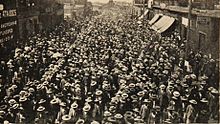Iquique massacre
The massacre of Iquique ( Spanish Matanza de la Escuela Santa María de Iquique ) was the shooting of several hundred to 3600 strikers and their families in 1907 in Iquique , Chile . The workers in the Chilean saltpetre industry in the Tarapacá region had campaigned for better working and living conditions.
Historical situation
After winning the saltpetre war (1879–1884), the saltpetre industry flourished in northern Chile. There were regular strikes and protests by the emerging labor movement . The workers lived in poverty; the wages were often paid out in the form of vouchers, which in turn could only be redeemed in the shops of the mining companies. The peso lost value. The working conditions were harsh and dangerous. Workers were repeatedly killed in strikes and protests.
Happenings
The strike movements of 1907 in the region around Iquique began on December 4th with a work stoppage of 300 railway workers of the saltpetre transports . In the following days dock workers and workers from other companies followed, on December 10th the workers of the saltpeter works of San Lorenzo . Later, the Santa Lucia saltpeter works were included, followed by other saltpeter works.
The demands of the Chilean, Peruvian and Bolivian workers included payment of wages in cash, stable real wages , better work safety and educational opportunities at evening schools. When the demands were not answered positively, around 2,000 workers moved to Iquique, where representatives of the English, Chilean, German, Spanish and Italian companies that exploited the region's raw materials were located. They reached the city on December 15th. Since the strikers refused to leave only one negotiating delegation, they were placed in the Domingo Santa Maria school. Several thousand residents of the surrounding areas, including women and children, also arrived in Iquique and supported the strikers. There were now about 7,000 people in and in front of the school.
The Chilean government of President Pedro Montt ordered that the local authorities declare a state of siege and prevent further protesters from arriving. Military units were sent into the city. The companies refused to negotiate under the pressure of a strike. The efforts of the local mayor Carlos Eastman in the days of December 19-21 were therefore unsuccessful.
Then he instructed the General of the Military Associations Roberto Silva Renard to vacate the school. After ultimatums and the threat of using two machine guns positioned in front of the area, fire was opened on the people on the afternoon of December 21. Large numbers of people were killed by the two machine guns and the firing infantry. The infantry entered the school and continued to fire, as did the Iquique racetrack, where the crowd was herded.
The Chilean government named 126 dead and 135 injured. Other estimates speak of several hundred, 2000 and more and 3600 deaths.
memory

The Chilean composer Luis Advis wrote the famous “Cantata de Santa María de Iquique” in 1969, it was first performed by the Quilapayún group.
A national commemoration was held on the 100th anniversary of the massacre on December 21, 2007 and a memorial site with information was created in Iquique.
Web links
Individual evidence
- ↑ depending on the source, see section "Events"
- ↑ a b c d e f Sergio Grez Toso: The School of Iquique , in: Le Monde diplomatique of December 14, 2007, accessed on June 23, 2020
- ↑ Bibliotheca Nacional de Chile: Masacre de la Escuela Santa María de Iquique , accessed on June 23, 2020
- ↑ Hamburg Historical Museums Foundation : PEKING and Chile's nitrate mining in the desert , accessed on June 23, 2020
- ↑ Iván Ljubetic Vargas: La masacre de la escuela Santa Maria , accessed on June 23, 2020
- ↑ a b Archivo Nacional de Chile: Matanza de la Escuela de Santa María de Iquique en 1907 , accessed on June 23, 2020
- ↑ www.santiagoamil.cl: QUILAPAYÚN - LA CANTATA SANTA MARÍA DE IQUIQUE, 50 AÑOS , accessed on June 26, 2020
- ↑ Homepage Luis Avids: Cantata de Santa María de Iquique , accessed on June 24, 2020
- ↑ La Tercera on December 21, 2007: Iquique será el epicentro de las conmemoraciones por los cien años de la matanza obrera , accessed on June 24, 2020
- ↑ Consejo de monumentos nacionales de Chile: Memorial a Los Mártires de La Escuela Santa María , accessed on June 23, 2020

